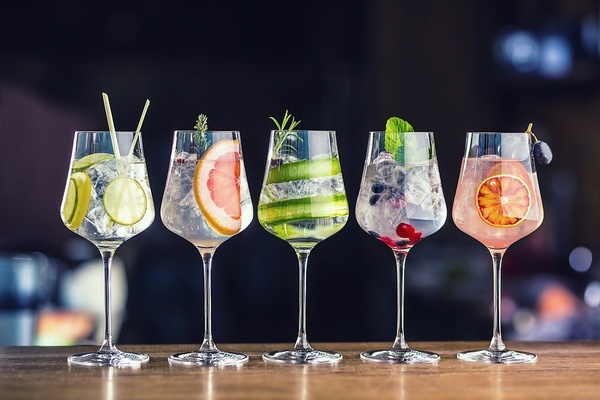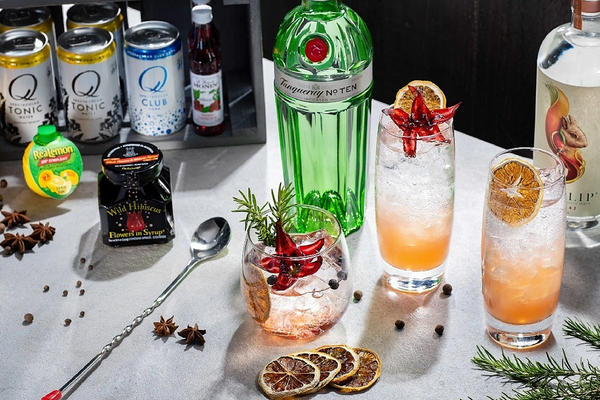What’s the Difference Between Gin and Vodka?
Updated by Taylor Tobin
Anytime you visit a** cocktail ** bar, you’re likely to notice numerous drinks on the menu that feature either gin or vodka as their core spirit. These liquors are most frequently poured in their unaged form—which gives them a clear hue rather than the brown color of aged spirits—and their light profile makes them an easy match for mixers, juices, and other popular cocktail ingredients.
That said, vodka and gin offer very different flavor profiles. Read on to find out exactly what makes each of these spirits unique and how to use them in cocktails.

What are gin and vodka made from?
We’ll start with vodka, which is traditionally made by fermenting and distilling grains like wheat, barley, and corn. Some distillers, however, like to swap out the grain for potato, providing the spirit with a unique flavor and mouthfeel. Vodka is typically distilled at least three times—with each distillation resulting in a smoother, crisper flavor—and then filtered through charcoal or carbon.
Gin , like many vodkas, starts with a grain mash that goes through fermentation and distillation. In this sense, gin and vodka are very similar. But in order to be considered gin, a clear, vodka-like spirit needs to be infused with one very specific botanical: juniper. In fact, the name gin comes from genièvre , the French word for juniper. Gin can also include any number of other aromatic herbs and plants: distillers have flavored gin with everything from citrus peel, to coriander, to sage, to lavender—even cucumber! But juniper is the only non-negotiable botanical for this spirit.
Which flavors are associated with gin and vodka?
Vodka is categorized as a “neutral” spirit, which means that, in its fundamental form, vodka doesn’t include any additional flavors or ingredients beyond the liquid that comes from the fermentation, distillation, and filtration processes. But that doesn’t mean that vodka doesn’t still have plenty of personality! Depending on the grain (or starchy tuber), the quality of the water, and the distillation and filtration, some vodkas have a sweeter taste than others (corn vodkas are well-known for this); some have a smoother profile than others (they don’t burn as harshly as they go down); and some have a richer mouthfeel than others (specifically, potato vodkas have a heavier, almost oily texture).
Vodka’s neutrality also makes it a prime candidate for flavor infusion. By adding fruit like grapefruit, cherries, or limes; herbs like vanilla bean, rosemary, and chamomile; and even quirky ingredients like bacon or tomato, you can transform the taste of this clear, clean spirit and the taste of the cocktails that you mix with it.
Speaking of infused vodka, gin essentially falls into that category. A neutral spirit is infused with juniper and other aromatics and—voila!—it becomes gin. The juniper gives gin a fragrant, pine-like flavor, which most distillers balance with citrus notes from lemon and orange peels and hints of spice from coriander and cardamom. There’s no limitation to the herbs, spices, and fruits that can be used for gin, so you’ll detect a wide range of different flavors in gins from different distilleries.
Do gin and vodka have the same alcohol content?
On average, gin and vodka have equivalent alcohol-by-volume (ABV) percentages. Gin ranges from 35 to 55 percent ABV, while most vodkas hover around 40 percent. Some outliers go all the way up to 95 percent!

Which cocktails are best suited to each spirit?
Some bartenders, both professional and amateur, view clear spirits as interchangeable in cocktails . While that’s not strictly true—gin and vodka offer very different flavor profiles, as we’ve discussed—you can feel free to play around with switching them in and out of recipes to see how they impact the finished beverage. Here’s a roundup of a few popular cocktails associated with gin and vodka, along with one classic libation that’s very closely linked to both spirits.
Gin:
- **Negroni: **This beloved Italian aperitivo consists of gin, Campari, sweet vermouth, and a slice or twist of orange. The recently-viral Negroni sbagliato replaces the gin with prosecco.
- French 75: The citrusy notes of gin are beautifully suited to the French 75, which contains gin, lemon juice, simple syrup, and Champagne.
- **Aviation: **A turn-of-the-century cocktail that’s been enjoying a resurgence in recent years, the aviation mixes gin with lemon juice, maraschino liqueur, and crème de violette, which gives it a vibrant purple hue that looks gorgeous in a vintage coupe glass.
Vodka:
- **Cosmopolitan: **This early-aughts megahit libation features vodka (either regular or citrus-flavored), Cointreau, cranberry juice, lime juice, and a twist of lemon.
- Moscow Mule : A spicy, tangy vodka drink served in a charming copper mug, the Moscow mule includes vodka, ginger beer, and lime juice.
- Espresso Martini: Like the cosmo, the somewhat-retro espresso martini is enjoying a new wave of appreciation from bar hoppers these days. It’s made with vodka, an espresso shot, coffee liqueur, and simple syrup.
Both:
- **Martini: **Many cocktail aficionados balk at the suggestion that the martini can be defined by any spirit other than gin, but working bartenders will tell you that vodka martinis are a popular-enough order to give vodka some claim over this beverage-world staple as well. (James Bond liked to mix the two spirits in his martinis, after all!)















